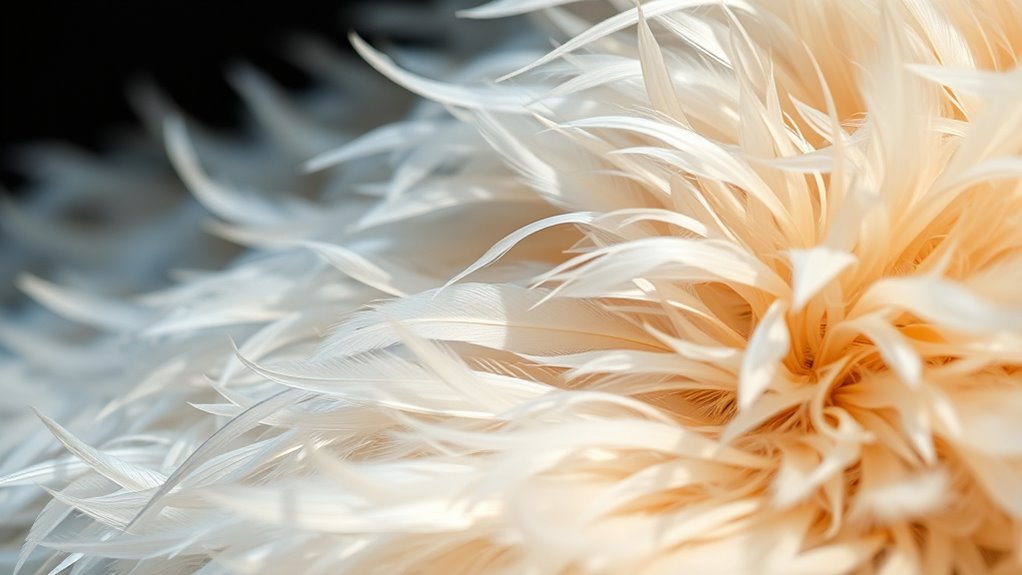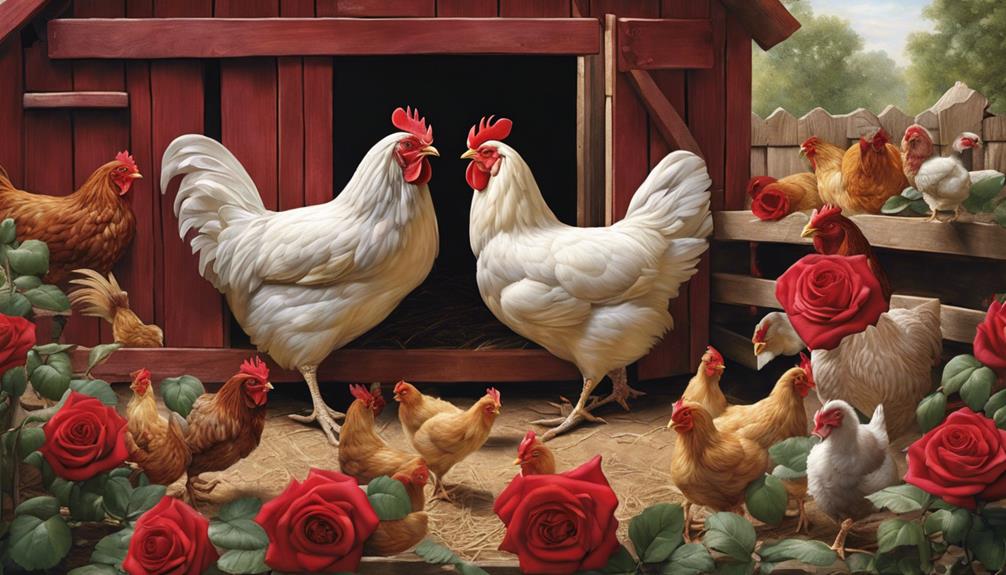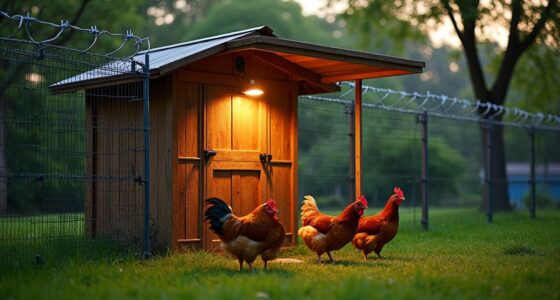You can transform chicken feathers into high-tech insulation by cleaning, sterilizing, and processing them into fluffy fibers similar to fiberglass or cellulose. These feathers, rich in keratin, trap air effectively, providing excellent thermal insulation. As a sustainable alternative, this method reduces waste and lowers environmental impact while delivering performance comparable to conventional materials. If you keep exploring, you’ll discover how these innovative feathers are revolutionizing eco-friendly building options.
Key Takeaways
- Chicken feathers are processed into fluffy fibers that serve as sustainable, high-performance insulation materials.
- The keratin-based structure traps air efficiently, providing excellent thermal insulation for buildings.
- The manufacturing process repurposes poultry waste, reducing environmental impact and promoting sustainability.
- Feather insulation is lightweight, easy to install, and can meet standard R-values and building codes.
- This innovative material offers an eco-friendly alternative to traditional insulation like fiberglass or foam.

If you’re looking for an eco-friendly and cost-effective insulation option, chicken feathers might surprise you. These feathers, often considered waste in poultry farming, are now being transformed through innovative feather processing methods into high-tech insulation materials. Instead of discarding them, manufacturers are finding ways to repurpose chicken feathers for insulation applications, creating sustainable solutions that benefit both the environment and your wallet. The process begins with feather processing, where feathers are cleaned, sterilized, and treated to remove any impurities. This step guarantees the resulting insulation material is safe, durable, and effective. Once processed, the feathers are turned into fluffy, fiber-like materials that resemble natural cellulose or fiberglass but with a much lower environmental footprint.
The key advantage of using chicken feathers in insulation applications is their natural structure. Feathers are composed of keratin, a protein that provides excellent thermal insulation properties. This means that when properly processed, chicken feather insulation can trap air efficiently, reducing heat transfer and keeping buildings warmer in winter and cooler in summer. Additionally, the lightweight nature of these feathers makes them easy to handle during installation, and their resilience helps maintain insulation performance over time. Because chicken feathers are naturally abundant and renewable, they offer a sustainable alternative to traditional insulation materials, which often rely on fossil fuels or environmentally damaging manufacturing processes.
Feather processing for insulation involves breaking down the feathers into fibers that can be compressed into mats or batts, suitable for various building applications. This transformation allows you to incorporate chicken feather insulation into walls, attics, and floors, just like conventional insulation materials. The versatility of these processed feathers means they can be tailored to meet specific R-values, confirming compliance with building codes and energy efficiency standards. Furthermore, the natural properties of chicken feathers make them resistant to pests and mold, adding an extra layer of durability and safety to your home or project. Leveraging cost-effective strategies such as local sourcing and streamlined processing can further reduce expenses and promote sustainable practices in production.
As you consider insulation options, you’ll find that chicken feathers not only match the performance of traditional materials but also do so with a considerably reduced environmental impact. The entire process of feather processing and conversion into insulation applications emphasizes sustainability, waste reduction, and energy efficiency. By choosing this innovative material, you’re supporting a circular economy that turns poultry byproducts into valuable resources. Fundamentally, chicken feathers transformed into high-tech insulation represent a smart, eco-conscious choice for builders and homeowners alike, aligning performance with environmental responsibility.
Frequently Asked Questions
How Does Chicken Feather Insulation Compare to Traditional Insulation Materials?
You might wonder how chicken feather insulation compares to traditional options. It offers impressive thermal efficiency, helping you save on energy bills. Plus, it’s eco-friendly, utilizing a renewable resource instead of synthetic materials. This insulation reduces environmental impact and provides effective heat retention. Overall, chicken feather insulation is a sustainable, efficient choice that outperforms many conventional insulations in both eco-friendly benefits and thermal performance.
Are There Any Health Risks Associated With Using Chicken Feathers Indoors?
You might wonder if there are health concerns using chicken feathers indoors. While they’re generally safe, allergen risks can exist if you’re sensitive to feathers or dust. Proper processing and treatment reduce these risks, but it’s wise to guarantee good ventilation and regular cleaning. If you have allergies or asthma, consult a healthcare professional before installation. Overall, when handled correctly, feather insulation poses minimal health concerns.
What Is the Environmental Impact of Processing Chicken Feathers Into Insulation?
You might wonder about the environmental impact of processing chicken feathers into insulation. By repurposing feather waste, you reduce landfill contributions and promote sustainability. However, processing emissions from transforming feathers can release pollutants if not properly managed. Overall, converting feather waste into insulation offers eco benefits, but you should consider the energy use and emissions during manufacturing to fully understand its environmental footprint.
Can Chicken Feather Insulation Be Recycled or Reused?
You can definitely recycle or reuse chicken feather insulation. Feather recycling programs are emerging, allowing you to repurpose insulation materials for other construction or insulation needs. This promotes insulation sustainability by reducing waste and extending the material’s life. Check with local recycling centers or manufacturers to see if they accept feather-based insulation, ensuring you contribute to eco-friendly practices and maximize the lifespan of this innovative, sustainable insulation option.
How Long Does Chicken Feather Insulation Typically Last?
You might wonder about the insulation’s lifespan. With proper installation, feather insulation typically lasts around 20 to 30 years, depending on factors like feather degradation and environmental conditions. Over time, feathers can degrade due to moisture or pests, which affects insulation longevity. Regular inspections help guarantee it maintains its insulating properties. Overall, feather insulation offers a durable, eco-friendly option that can serve you well for decades if well-maintained.
Conclusion
Now, imagine turning a common farmyard waste into a superhero of insulation—like transforming a humble feather into a fortress for warmth. You hold the power to reduce waste and boost energy efficiency all at once. This innovation isn’t just about comfort; it’s about giving new life to what’s often discarded, weaving sustainability into your everyday world. So, next time you see chicken feathers, think of them as tiny warriors ready to protect your home in style.










